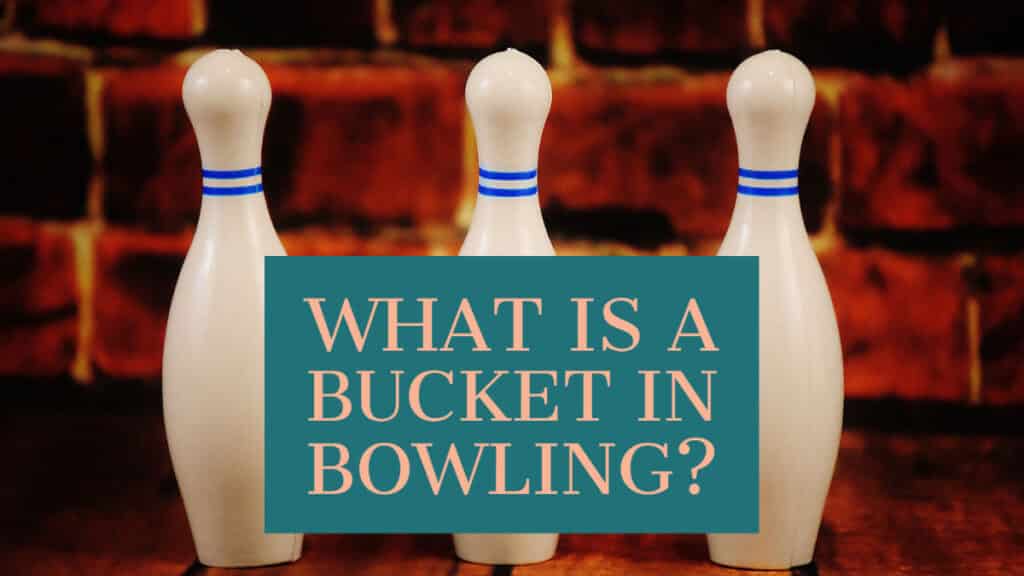Bowling is an incredibly technical and skill-based game that requires a lot of knowledge and understanding to master. That is why knowing the basics of bowling is a must. Some people might think there is not much to learn about this sport but, there are rules not many people are even aware of!
One significant term in bowling is a bucket that you should surely know about. So, the question is, what is a bucket in bowling and how to score it? Well, you do not need to worry because that is exactly what I am here to tell you.
In this article, I will talk about pin arrangement in ten-pin bowling, what a bucket is, types of buckets in bowling, and how you can perfectly score it. So, make sure you read this article till the end to increase your professional knowledge of the incredible sport of bowling.

Understanding the Pin Arrangement
To understand what a bucket is, you need to know about the pin deck’s arrangement at the end of the bowling lane perfectly. There are ten 15-inch pins at the end of the bowling lane in a standard game of bowling.
These pins are arranged in an equilateral triangle with numbering from left to right and front to back. To score, you are going to need to knock as many pins in a single shot as you can.
Using scoring elements, including strikes, spares, and open frames, you are going to make sure you score as many points as you can within your 10 frames with two shots each. The player with the most score at the end of the game will win.
Bucket in Bowling
A bucket is a special kind of spare arrangement in bowling where a cluster of standing pins creates a diamond shape. They are also referred to as dinner buckets by some professional players.
In some regions of the world, clusters of three standing pins are also called buckets. Let us look at different types of buckets that are commonly encountered by players.
2, 4, 5, 8 Bucket
A bucket with the 2, 4, 5, and 8 pins still standing and need to be knocked to achieve a spare is known as the 2, 4, 5, 8 bucket. It is much more common in occurrence than others.
3, 5, 6, 9 Bucket
A cluster of 4 standing pins which include the 3, 5, 6, and 9 number pins, is known as the 3, 5, 6, 9 bucket, which is also much more common than other types of buckets.
1, 2, 3, 5 Bucket
The rarest and least occurring bucket in professional bowling is the 1, 2, 3, 5 bucket, which has the 1, 2, 3, and 5 pins standing to achieve a spare. It is difficult to see because most players go for a pocket with the leading pin.
2, 4, 5 and 3, 5, 6 Bucket
Although not diamond-shaped buckets, clusters of 2, 4, and 5 pins and 3, 5, and 6 pins are sometimes considered buckets depending upon the region you might be in.
Bucket for Lefties
The 3, 5, 6, 9 bucket is a tough one to achieve. You must make sure that your ball hits each of the pins and does not deflect after hitting any single pin of the arrangement.
It is considered to be the bucket for lefties because left-handed bowlers hook and curve towards the balls. Knocking the diamond cluster leads to the players achieving a spare.
Bucket for Righties
The 2, 4, 5, 8 bucket pattern are the hardest bucket to get a spare off. This is because it is widespread for the bowling ball to deflect the number 8 pin, halting the spare.
The reason for the 2, 4, 5, 8 buckets being ideal for right-handed bowling players is that they are supposed to angle the ball towards the left side with a hook or curve to achieve the spare.
How to Score a Bucket
Now that you know what a bucket is, I believe the appropriate next step is to learn how to score a bucket. Well, the technique differs for different-handed players facing different types of buckets.
Let us look at how you can score a bucket accurately.
- The most important thing you need to consider while trying to get a bucket is hitting the leading pin. This will help you knock the other pins through deflection.
- If you are facing a 3, 5, 6, 9 bucket, which is less difficult than the 2, 4, 5, 8 buckets, the appropriate decision would be to go for a hook.
- This is important because, like in a 10-pin arrangement, looking for a pocket is important to score a strike; in a bucket, hooking allows you to find a pocket.
- People also tend to go for a straight-forward uniform throw, but that is better to knock down a 1, 2, 3, 5 cluster since the entirety of the cluster is in the middle, but make sure you know how to throw the perfect straight ball if you are taking the risk.
- Upon facing the much more difficult 2, 4, 5, 8 clusters, you are going to want only to use the hook. The hook will be a much better option to score the spare.
- Another thing you should seek while trying to get a bucket spare is the deflection of pins. It is possible to get the pin action going so the pins can knock each other out upon the bowling ball’s impact.
Check out these best-selling bowling balls.
Conclusion
Scoring a bucket is surely a skill only experienced professionals possess since they are the most difficult kind of spare to achieve. But with this information, I believe you can get the job done.
I hope you learned a lot from this guide, and now your bowling knowledge has increased quite a lot. Make sure you utilize this knowledge the next time you are in the bowling alley with your friends and family so that you have a great bowling experience.





